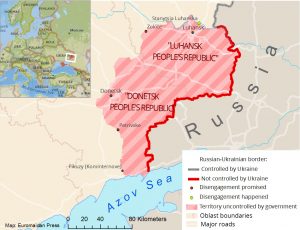
A Donetsk resident who was forced to leave his hometown due to the war back in 2014, journalist Denis Kazansky is now one of the Ukrainian delegates in the so-called Trilateral Contact Group, which negotiates peace for the east of Ukraine with Russians under the OSCE mediation.
In his video blog, Kazansky explained that he can’t disclose the identities of those who participated in the investigation, however, says that one of the investigators is known on Twitter under the alias Iosif Pichonet. This Twitter user often publishes various insider data related to Donetsk railways in the occupied part of Donetsk Oblast.
Denis Kazansky presented the results of the investigation that is based on the official data purchased by the investigators for 3,000 rubles from a Russian railway tracking service “Gde vagon” (“where is the car”).
The service run by the Russian company B2R that uses Russian Railway’s data on the railway traffic in Russia allows to track a car by its serial number, get the history of usage of a particular car, or obtain the data on traffic through a station in a given period of time. Recently, investigators of CIT used the same service to track flatbed cars with Russian military equipment that moved towards the Ukrainian border in late March and in April 2019.


The order receipt presented in the video shows that the investigators have ordered the data on “all cargo traffic through Uspenskaya Station” in the period between 1 January 2015 and 31 December 2015, though the video gives a glimpse only into the data that pertains to January 2015.
The station is located in the small Russian village of Avilo-Uspenka that lies literally on the Ukrainian border with the frontier running along the edge of the village.
Among the freight trains the station of Uspenskaya saw circulating in January 2015, according to the data, multiple trainloads of cargos were marked as “explosive substances,” “engine petrol,” and diesel fuel that arrived at the station in January 2015 amid the battles of Debaltseve and for Donetsk Airport.
The population of Avilo-Uspenka is under 1000 people and its station Uspenskaya doesn’t have any facilities to unload the petroleum, oil, and lubricants (POL) while the stretch of the railway coming through the village starts in the regional capital of Rostov, runs through Taganrog, and stretches further on across the Ukrainian border to the railway hub of Ilovaisk southeast of Donetsk.
Russia was in control of this railway entrance to Ukraine from spring 2014, and months later – in August 2014 – the hybrid Russian forces took control of Ilovaisk. After the fall of Ilovaisk, the Russian forces used the city’s railway facilities extensively to manage Russian supplies that were coming by train from Rostov.
“We can see here that the lion’s share of all cargoes arriving from Russia on the border with ORDLO in the days of the Battle for Debaltseve make cargoes of two types: fuel/POL, and explosives… Literally every day, dozens of wagons with explosives arrived at the Uspenskaya station from different parts of Russia and each train brought tens and hundreds of tons of these very explosive materials,” says Denis Kazansky in his video.
Kazansky says that the “explosive substances” that transited through the Uspenskaya station in January 2015 amounted to thousands of tons. There is no data that trainloads ever returned back to exit stations. Moreover, the departure stations from which this type of cargo originated exclude the industrial nature of the explosives as those stations don’t have any industrial explosive production or storage facilities in their areas with only military facilities such as ammunition depots located nearby.
The video published in April 2015 shows the dangerous unloading process of artillery ammunition from a Russian freight car, reportedly in Sukhodilsk at Krasnodon station, Luhansk Oblast. The exact date the video was filmed is unknown.
Here are a few examples of the departure stations of the trains that delivered what was marked as “explosive substances” to Uspenskaya in January 2015:
- Bezmenovo, Novosibirsk Oblast is home to the military unit 86775 – the 1819th base of artillery ammunition;
- Bogandinskaya, Tumen Oblast is located in the settlement of Bogandinsky, home to military unit 58661 with the artillery ammunition storage facility.
- Butylitsy, Vladimir Oblast with the military unit 96570 in the nearby village of Zlobino.
The Twitter user “Iosif Pinochet,” who initiated the investigation, wrote on his Twitter :
“Approximately 60,000 tons of explosives were brought to the stations Gukovo and Uspenskaya (both in Rostov Oblast on the Ukrainian border, – Ed.) in the course of 12 days of January 2015. There were also the last 4 months of 2014 and we don’t have data on them yet, but if you’d just count 50,000 tons [for each month], you’ll get 250,000 tons of missiles and shells.”
However, the investigation presented by Denis Kazansky may help to quantify the amounts of ammunition and fuel Russia supplied in the occupation zone for its troops.
The video presents only several finds and has to do only with Uspenskaya station on Russia’s main railway channel for smuggling military equipment and materials into Ukraine’s Donetsk Oblast at the time. Unfortunately, no results were presented on the railway traffic through the station of Gukovo, the border transit point on Russia’s same channel for occupied Luhansk Oblast.
Read more:
- Commemorating Ilovaisk, bloody August battle that changed world’s view of war in Ukraine
- New footage shows Russian PMC Wagner involved in crucial 2015 Debaltseve battle in Ukraine
- Debaltseve Diaries – Debaltseve under first attacks
- In memoriam: The Defense of Donetsk Airport (25 May 2014 – 22 January 2015)







